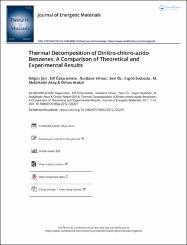| dc.contributor.author | Sen, Nilgun | |
| dc.contributor.author | Ozkaramete, Elif | |
| dc.contributor.author | Yilmaz, Nurdane | |
| dc.contributor.author | Oz, Sevi | |
| dc.contributor.author | Svoboda, Ingrid | |
| dc.contributor.author | Akay, M. Abdulkadir | |
| dc.contributor.author | Atakol, Orhan | |
| dc.date.accessioned | 2019-11-24T20:38:38Z | |
| dc.date.available | 2019-11-24T20:38:38Z | |
| dc.date.issued | 2014 | |
| dc.identifier.issn | 0737-0652 | |
| dc.identifier.uri | https://dx.doi.org/10.1080/07370652.2012.725237 | |
| dc.identifier.uri | https://hdl.handle.net/20.500.12513/2555 | |
| dc.description | WOS: 000321887300001 | en_US |
| dc.description.abstract | 1,2-Dichloro benzene (I) and 1,2,3-trichloro benzene (II) were nitrated under appropriate strong conditions. Nitrated mixtures were reacted with NaN3 in polar solvents. As a result of the nucleophilic substitution, mixtures of nitro-chloro-azido benzene were prepared. After fractional crystallization, two crystalline substances were obtained from the mixtures. These crystalline substances were characterized by infrared (IR), H-1-NMR spectroscopy, mass spectroscopy, and elemental analysis. It was understood that the substance obtained from compound I was 2-chloro-4,6-dinitro azido benzene (III). The crystals of compound III were suitable for single-crystal X-ray diffraction (XRD). The molecular structure of this substance was determined by the mentioned method, XRD. It was revealed that the crystalline substance obtained from compound II was most probably 1,5-dinitro-2,4-diazido-3-chloro benzene (IV). In addition, compounds III and IV were investigated by thermogravimetry (TG) and differential scanning calorimetry (DSC). Compound III turned into 4-nitro-6-chloro phenoxazine (V) at about 120 degrees C with an exothermic reaction. Compound IV completely decomposed at about 150 degrees C with an exothermic reaction similar to that of explosive materials. In addition, theoretical formation enthalpies of compounds III and IV were calculated with Gaussian 09, CBS-4M algorithm. The enthalpies of thermal reactions observed in the TG curves were calculated using the theoretical formation enthalpies. Finally, the theoretical results were compared with the experimental findings obtained from DSC. | en_US |
| dc.description.sponsorship | University of AnkaraAnkara University [12B4240003]; TUBITAKTurkiye Bilimsel ve Teknolojik Arastirma Kurumu (TUBITAK) | en_US |
| dc.description.sponsorship | Financial support of this work by the University of Ankara Scientific Research Fund under contract no. 12B4240003 is gratefully acknowledged. We are indebted to and thank Prof. Dr. Wolfgang Donner for providing laboratory facilities at TU Darmstadt. One of us (E.G.O) acknowledges financial support by TUBITAK (Ph.D. studies). | en_US |
| dc.language.iso | eng | en_US |
| dc.publisher | TAYLOR & FRANCIS INC | en_US |
| dc.relation.isversionof | 10.1080/07370652.2012.725237 | en_US |
| dc.rights | info:eu-repo/semantics/closedAccess | en_US |
| dc.subject | azido-nitro compounds | en_US |
| dc.subject | DSC | en_US |
| dc.subject | heat of formation | en_US |
| dc.subject | TG | en_US |
| dc.subject | theoretical calculation | en_US |
| dc.title | Thermal Decomposition of Dinitro-chloro-azido Benzenes: A Comparison of Theoretical and Experimental Results | en_US |
| dc.type | article | en_US |
| dc.relation.journal | JOURNAL OF ENERGETIC MATERIALS | en_US |
| dc.contributor.department | Kırşehir Ahi Evran Üniversitesi, Fen-Edebiyat Fakültesi, Kimya Bölümü | en_US |
| dc.identifier.volume | 32 | en_US |
| dc.identifier.issue | 1 | en_US |
| dc.identifier.startpage | 1 | en_US |
| dc.identifier.endpage | 15 | en_US |
| dc.relation.publicationcategory | Makale - Uluslararası Hakemli Dergi - Kurum Öğretim Elemanı | en_US |


















